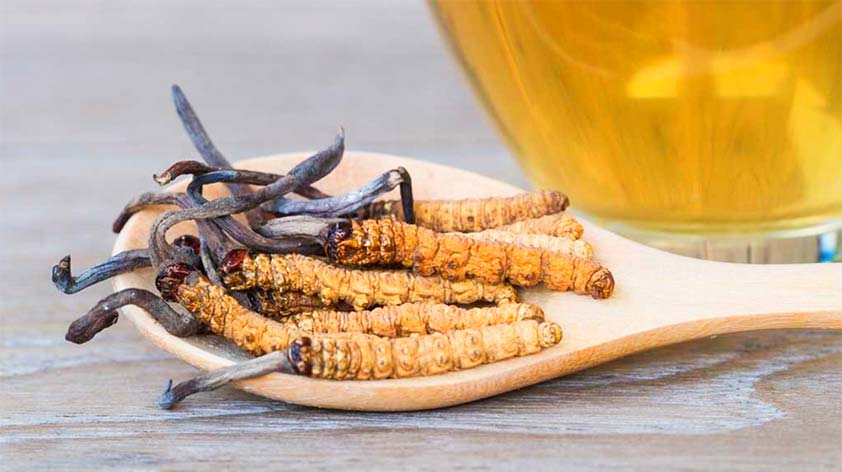
Here is another mushroom that most of us may not have heard of: Cordyceps mushrooms (also known as caterpillar fungus) are a fungus typically found in the Tibetan Plateau and Himalayan regions of Nepal. Now before you get scared about its origins, this mushroom is a highly-valued ingredient in Traditional Chinese Medicine (TCM) and herbal medicine; long usage history suggests they are non-toxic.
Cordyceps sinensis (a parasite) invade hepial moth’s larvae, absorbing its nutrients and reproducing, thus causing the larvae to die. Hence, in Chinese it is called 冬虫夏草 (or虫草) , because the literal translation of ‘虫草 ‘ is insect grass. It’s listed as one of the “three major tonics” in China, along with ginseng. Intrigued? Then read on for Cordyceps Mushroom: Top 3 Health Benefits with Recipes!
1. Kidney Support
Cordyceps can help improve kidney function and reduce kidney damage as studies have shown that serum creatinine levels in participants were significantly decreased. Creatinine can give an estimate of how well the kidney filters as it is a waste product from typical wear and tear of the muscles. However, these studies are not of the highest quality, so the results are not categorical as yet. Nevertheless, cordyceps do provide a variety of trace elements such as serum iron and increase production of haemoglobin levels in patients with chronic kidney disease.
2. Lung Protection
This is especially important during the COVID-19 pandemic. The fungus contains cordycepic acid (or D-mannitol) which helps to regulate bronchial smooth muscle, therefore encouraging breathing to become smoother. It also enhances the activity of bronchial cilia, the lung’s self-cleaning ability, and an accelerated removal of lung waste. It has been found that cordycepin has strong inhibitory effects on mycobacterium tuberculosis and other bacteria, thus its role in preventing lung infections.
3. Anti-Tumour Properties
The aforementioned cordycepin is a biocidal compound which possesses anti-tumour properties. The growth of cancerous cells is inhibited, which has been proven by several studies (however do note that they were conducted in test tubes and animals, not humans). Aside from having anti-tumour properties, it also has an anti-inflammatory effect. Cordyceps’ polysaccharide also exerts anti-tumour influences by activating the host immune response. Now that we know its benefits and that it is safe to consume, below are some simple ways to get it into your diet.
Recipes to Implement Cordyceps Mushrooms into your Diet
Drink with Goji Berries as a Tea
The simplest way is to decoct the cordyceps for under 30 minutes because consuming it as if drinking tea, is not sufficient to release its nutrients and desirable components. You can decoct it solo or mix it with other medicinal herbs such as goji berries and/or gastrodia depending on what you are trying to treat.
Congee (Chinese Rice Porridge)
Another easy method is to make congee (Chinese rice porridge) by cooking 2-3g of cordyceps mushrooms, 50g of your choice of meat or plant-based equivalent and desired amount of rice in a pot. When cooking congee, you would add more water than you would when making rice (again depending on your preferred consistency) but basically, you can just throw everything in the pot and wait for it to cook, then season to taste with salt and pepper.
Traditional Tibetan Method
The traditional method recommended by the Tibetan Haji for the nourishing of the kidneys and lungs is to boil it with a duck (or chicken). Ingredients, one whole duck, 10g cordyceps, ginger, green onions, seasoning: cooking wine, salt and pepper Method: Clean the duck and pre-boil it to remove the smell, let it cool. Wash the cordyceps, cut ginger and green onions. Put the ingredients into the belly of the duck and place it in a pot. Pour bouillon (or broth) and season to taste with salt, pepper and cooking wine. Steam for about 2 hours over low fire and serve.
High quality cordyceps are currently on the more premium side of the scale pricewise, however you can buy them as a supplement powder or extract capsules which are far more affordable (do read the label before buying). Now that you’ve learned a bit about this fungus and its benefits, how keen are you (or not) to try it out? Tried cordyceps before? What effects and results did you notice? Let us know in the comments below or on Facebook, Twitter & Instagram!









